Ryan Cotterell
ETH Zurich
Bearing Syntactic Fruit with Stack-Augmented Neural Networks
Nov 05, 2025Abstract:Any finite set of training data is consistent with an infinite number of hypothetical algorithms that could have generated it. Studies have shown that when human children learn language, they consistently favor hypotheses based on hierarchical syntactic rules without ever encountering disambiguating examples. A recent line of work has inquired as to whether common neural network architectures share this bias, finding that they do so only under special conditions: when syntactically supervised, when pre-trained on massive corpora, or when trained long past convergence. In this paper, we demonstrate, for the first time, neural network architectures that are able to generalize in human-like fashion without any of the aforementioned requirements: stack-augmented neural networks. We test three base architectures (transformer, simple RNN, LSTM) augmented with two styles of stack: the superposition stack of Joulin & Mikolov (2015) and a nondeterministic generalization of it proposed by DuSell & Chiang (2023). We find that transformers with nondeterministic stacks generalize best out of these architectures on a classical question formation task. We also propose a modification to the stack RNN architecture that improves hierarchical generalization. These results suggest that stack-augmented neural networks may be more accurate models of human language acquisition than standard architectures, serving as useful objects of psycholinguistic study. Our code is publicly available.
Probability Distributions Computed by Hard-Attention Transformers
Oct 31, 2025

Abstract:Most expressivity results for transformers treat them as language recognizers (which accept or reject strings), and not as they are used in practice, as language models (which generate strings autoregressively and probabilistically). Here, we characterize the probability distributions that transformer language models can express. We show that making transformer language recognizers autoregressive can sometimes increase their expressivity, and that making them probabilistic can break equivalences that hold in the non-probabilistic case. Our overall contribution is to tease apart what functions transformers are capable of expressing, in their most common use-case as language models.
Transformers are Inherently Succinct
Oct 22, 2025Abstract:We propose succinctness as a measure of the expressive power of a transformer in describing a concept. To this end, we prove that transformers are highly expressive in that they can represent formal languages substantially more succinctly than standard representations of formal languages like finite automata and Linear Temporal Logic (LTL) formulas. As a by-product of this expressivity, we show that verifying properties of transformers is provably intractable (i.e. EXPSPACE-complete).
Language Models over Canonical Byte-Pair Encodings
Jun 09, 2025Abstract:Modern language models represent probability distributions over character strings as distributions over (shorter) token strings derived via a deterministic tokenizer, such as byte-pair encoding. While this approach is highly effective at scaling up language models to large corpora, its current incarnations have a concerning property: the model assigns nonzero probability mass to an exponential number of $\it{noncanonical}$ token encodings of each character string -- these are token strings that decode to valid character strings but are impossible under the deterministic tokenizer (i.e., they will never be seen in any training corpus, no matter how large). This misallocation is both erroneous, as noncanonical strings never appear in training data, and wasteful, diverting probability mass away from plausible outputs. These are avoidable mistakes! In this work, we propose methods to enforce canonicality in token-level language models, ensuring that only canonical token strings are assigned positive probability. We present two approaches: (1) canonicality by conditioning, leveraging test-time inference strategies without additional training, and (2) canonicality by construction, a model parameterization that guarantees canonical outputs but requires training. We demonstrate that fixing canonicality mistakes improves the likelihood of held-out data for several models and corpora.
Syntactic Control of Language Models by Posterior Inference
Jun 08, 2025Abstract:Controlling the syntactic structure of text generated by language models is valuable for applications requiring clarity, stylistic consistency, or interpretability, yet it remains a challenging task. In this paper, we argue that sampling algorithms based on the posterior inference can effectively enforce a target constituency structure during generation. Our approach combines sequential Monte Carlo, which estimates the posterior distribution by sampling from a proposal distribution, with a syntactic tagger that ensures that each generated token aligns with the desired syntactic structure. Our experiments with GPT2 and Llama3-8B models show that with an appropriate proposal distribution, we can improve syntactic accuracy, increasing the F1 score from $12.31$ (GPT2-large) and $35.33$ (Llama3-8B) to about $93$ in both cases without compromising the language model's fluency. These results underscore both the complexity of syntactic control and the effectiveness of sampling algorithms, offering a promising approach for applications where precise control over syntax is essential.
Information Locality as an Inductive Bias for Neural Language Models
Jun 05, 2025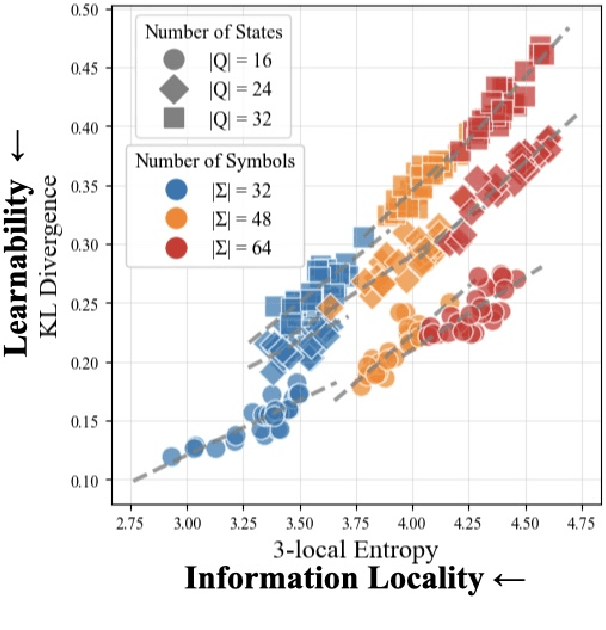


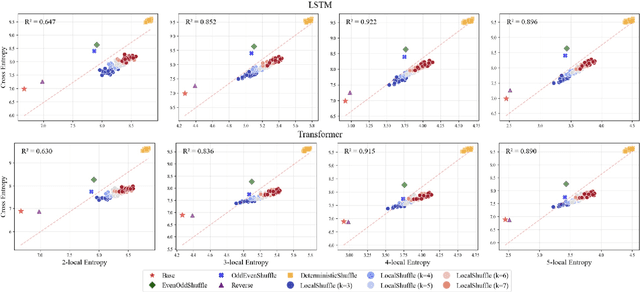
Abstract:Inductive biases are inherent in every machine learning system, shaping how models generalize from finite data. In the case of neural language models (LMs), debates persist as to whether these biases align with or diverge from human processing constraints. To address this issue, we propose a quantitative framework that allows for controlled investigations into the nature of these biases. Within our framework, we introduce $m$-local entropy$\unicode{x2013}$an information-theoretic measure derived from average lossy-context surprisal$\unicode{x2013}$that captures the local uncertainty of a language by quantifying how effectively the $m-1$ preceding symbols disambiguate the next symbol. In experiments on both perturbed natural language corpora and languages defined by probabilistic finite-state automata (PFSAs), we show that languages with higher $m$-local entropy are more difficult for Transformer and LSTM LMs to learn. These results suggest that neural LMs, much like humans, are highly sensitive to the local statistical structure of a language.
The Harmonic Structure of Information Contours
Jun 04, 2025

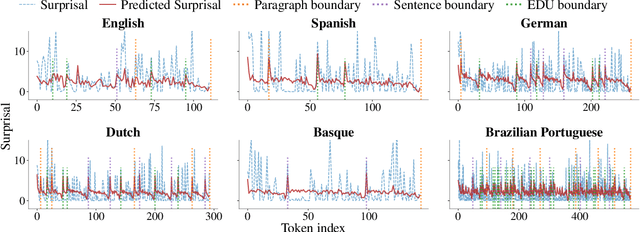
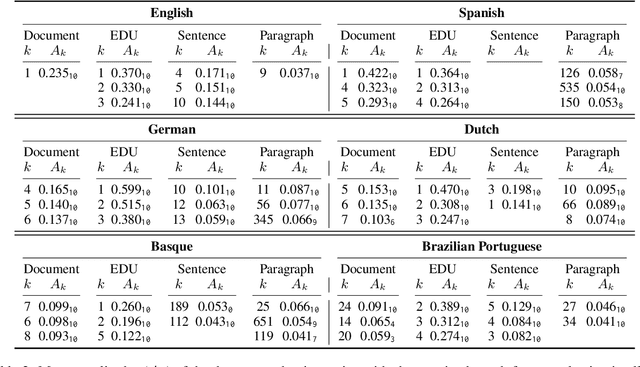
Abstract:The uniform information density (UID) hypothesis proposes that speakers aim to distribute information evenly throughout a text, balancing production effort and listener comprehension difficulty. However, language typically does not maintain a strictly uniform information rate; instead, it fluctuates around a global average. These fluctuations are often explained by factors such as syntactic constraints, stylistic choices, or audience design. In this work, we explore an alternative perspective: that these fluctuations may be influenced by an implicit linguistic pressure towards periodicity, where the information rate oscillates at regular intervals, potentially across multiple frequencies simultaneously. We apply harmonic regression and introduce a novel extension called time scaling to detect and test for such periodicity in information contours. Analyzing texts in English, Spanish, German, Dutch, Basque, and Brazilian Portuguese, we find consistent evidence of periodic patterns in information rate. Many dominant frequencies align with discourse structure, suggesting these oscillations reflect meaningful linguistic organization. Beyond highlighting the connection between information rate and discourse structure, our approach offers a general framework for uncovering structural pressures at various levels of linguistic granularity.
Characterizing the Expressivity of Transformer Language Models
May 29, 2025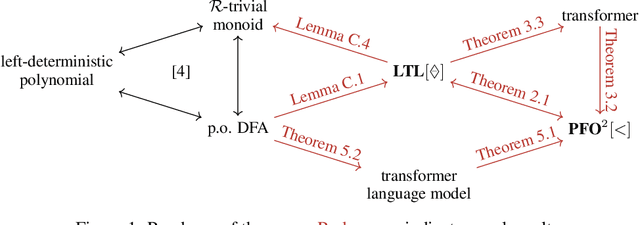
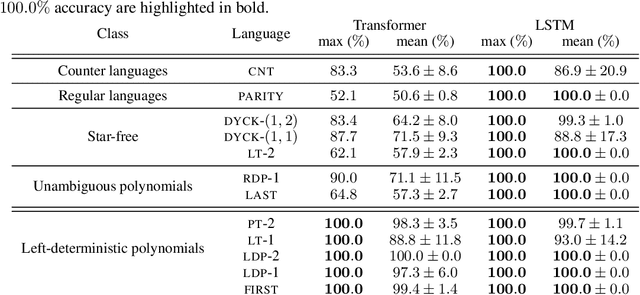

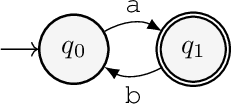
Abstract:Transformer-based language models (LMs) have achieved widespread empirical success, but their theoretical expressive power remains only partially understood. Prior work often relies on idealized models with assumptions -- such as arbitrary numerical precision and hard attention -- that diverge from real-world transformers. In this work, we provide an exact characterization of fixed-precision transformers with strict future masking and soft attention, an idealization that more closely mirrors practical implementations. We show that these models are precisely as expressive as a specific fragment of linear temporal logic that includes only a single temporal operator: the past operator. We further relate this logic to established classes in formal language theory, automata theory, and algebra, yielding a rich and unified theoretical framework for understanding transformer expressivity. Finally, we present empirical results that align closely with our theory: transformers trained on languages within their theoretical capacity generalize perfectly over lengths, while they consistently fail to generalize on languages beyond it.
Towards Developmentally Plausible Rewards: Communicative Success as a Learning Signal for Interactive Language Models
May 09, 2025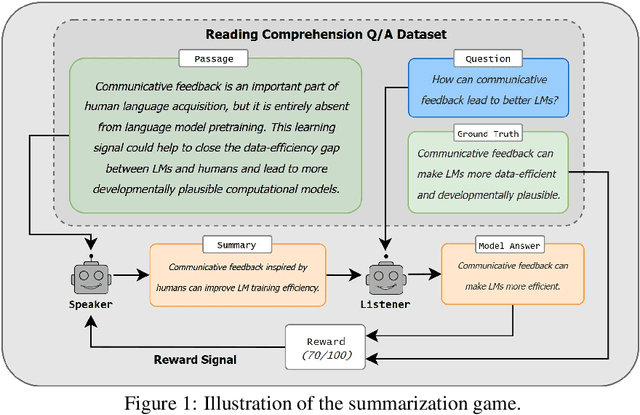
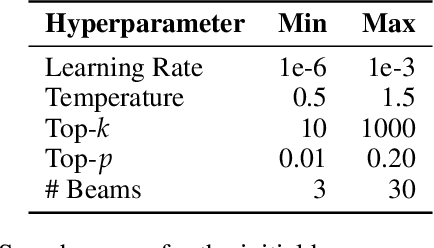
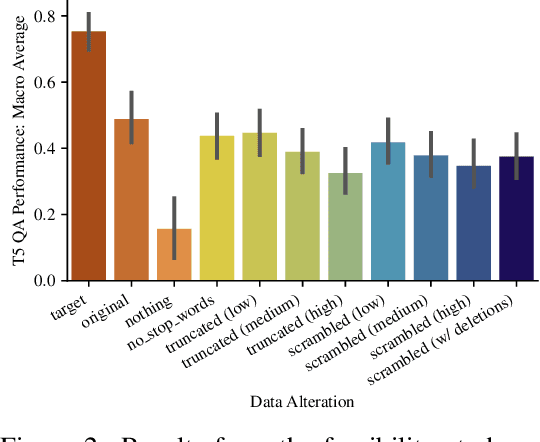
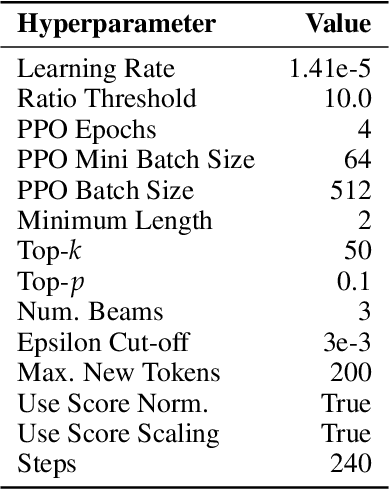
Abstract:We propose a method for training language models in an interactive setting inspired by child language acquisition. In our setting, a speaker attempts to communicate some information to a listener in a single-turn dialogue and receives a reward if communicative success is achieved. Unlike earlier related work using image--caption data for interactive reference games, we operationalize communicative success in a more abstract language-only question--answering setting. First, we present a feasibility study demonstrating that our reward provides an indirect signal about grammaticality. Second, we conduct experiments using reinforcement learning to fine-tune language models. We observe that cognitively plausible constraints on the communication channel lead to interpretable changes in speaker behavior. However, we do not yet see improvements on linguistic evaluations from our training regime. We outline potential modifications to the task design and training configuration that could better position future work to use our methodology to observe the benefits of interaction on language learning in computational cognitive models.
Syntactic and Semantic Control of Large Language Models via Sequential Monte Carlo
Apr 18, 2025



Abstract:A wide range of LM applications require generating text that conforms to syntactic or semantic constraints. Imposing such constraints can be naturally framed as probabilistic conditioning, but exact generation from the resulting distribution -- which can differ substantially from the LM's base distribution -- is generally intractable. In this work, we develop an architecture for controlled LM generation based on sequential Monte Carlo (SMC). Our SMC framework allows us to flexibly incorporate domain- and problem-specific constraints at inference time, and efficiently reallocate computational resources in light of new information during the course of generation. By comparing to a number of alternatives and ablations on four challenging domains -- Python code generation for data science, text-to-SQL, goal inference, and molecule synthesis -- we demonstrate that, with little overhead, our approach allows small open-source language models to outperform models over 8x larger, as well as closed-source, fine-tuned ones. In support of the probabilistic perspective, we show that these performance improvements are driven by better approximation to the posterior distribution. Our system builds on the framework of Lew et al. (2023) and integrates with its language model probabilistic programming language, giving users a simple, programmable way to apply SMC to a broad variety of controlled generation problems.
 Add to Chrome
Add to Chrome Add to Firefox
Add to Firefox Add to Edge
Add to Edge